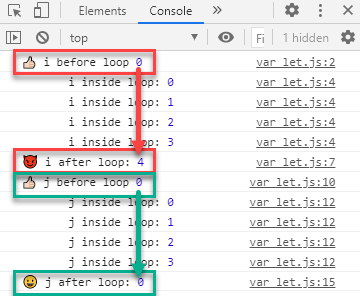# Basic syntax
- JavaScript within an HTML page is always enclosed by a
<script> ... </script>tag- The code of inline scripts can be added directly between these tags
- Just like with CSS, you can also reuse JavaScript code over multiple pages
- Save the script in a text file with the extension .js
- The
srcattribute of the<script>tag should refer to this .js-file
- If possible, place the script at the bottom of the HTML page, just before closing the
bodyelement - Separate words are separated by one or more spaces
- Every JavaScript statement ends with a semicolon
;- Browsers can also execute the command without the semicolon, but make a (good) habit of adding them anyway
<!DOCTYPE html> <html lang="en"> <head> .... </head> <body> .... <script> // Inline script </script> <script src="externalScript.js"></script> </body> </html>Copied!
1
2
3
4
5
6
7
8
9
10
11
12
13
2
3
4
5
6
7
8
9
10
11
12
13
# Comments
- Use
// ...for single line comments or/* ... */for multi-line comments
<script> // This is a single line comment /* This comment section spans several lines */ </script>Copied!
1
2
3
4
5
6
7
8
2
3
4
5
6
7
8
TIP
In PhpStorm you can use the shortcuts CTRL + / (single line comment) or CTRL + SHIFT + / (multi-line comment)
# Variables and data types
NAMING CONVENTIONS
- Variables starts with the keyword
constorlet- Use
constif the value never changes - Use
letif the value changes over time
- Use
- Variable names start with a letter, an underscore
_or a dollar sign$(never start a variable name with a number!) and contain only alpha-numeric characters (no spaces!) - Variable names are case-sensitive
- JavaScript is weakly typed (the type of a variable can change over time)
- We recommend using the camelCase notation for variable names (as most JavaScript programmers do)
| (Primitive) data types | Example | typeof returns |
|---|---|---|
| number | 5, 3.14, 34e-2 (= 0.34), 2_500 (= 2500) ... | number |
| string | "string 1", 'string 2' or `string 3` | string |
| boolean | true or false | boolean |
| array | ['red, 'green', 'blue'] | object |
| object | {firstName:'John', lastName:'Doe'} | object |
| null | an empty or non-existent value | object |
| undefined | a variable has been declared, but not defined | undefined |
- You can check the data type of a variable with the
typeofmethod
const nr = 17; const str = 'John Doe'; const bool = true; const arr = ['red', 'green', 'blue']; const obj = {firstName: 'John', lastName: 'Doe'}; const noValue = null; const undef = undefined; console.log('typeof nr:', typeof nr); // typeof nr: number console.log('typeof str:', typeof str); // typeof str: string console.log('typeof bool:', typeof bool); // typeof bool: boolean console.log('typeof arr:', typeof arr); // typeof arr: object console.log('typeof obj:', typeof obj); // typeof obj: object console.log('typeof noValue:', typeof noValue); // typeof noValue: object console.log('typeof undef:', typeof undef); // typeof undef: undefinedCopied!
1
2
3
4
5
6
7
8
9
10
11
12
13
14
15
2
3
4
5
6
7
8
9
10
11
12
13
14
15
REMARK: Data type of array/null
- Note that an array (and
null) does not have its own, primitive datatype - In JavaScript, an array (and
null) is always an object
- Open es6/syntax/dataTypes.html and es6/syntax/dataTypes.js in PhpStorm
- Open the Developer Tools (
F12) and look at the output under the Console tab
- Open the Developer Tools (

WARNING: Don't use var!
- In the early days of JavaScript, all variables are declared with the
varkeyword - Nowadays we don't use
varanymore because it causes a lot of problems! varhas a DIFFERENT scope thanlet!- Open es6/syntax/var_let.html and es6/syntax/var_let.js and look at this example:
- Line 1: create variable
var i = 0 - Line 3: create a loop with a new (???) variable
ifor the loop - Line 7: the output is not what you expected (at line 3, you didn't create a NEW variable, but you were still using the previous
i) - Lines 9 and 11: this time we replaced
varwithlet - Line 15: now the output is what we expected!
- Line 1: create variable
- Open es6/syntax/var_let.html and es6/syntax/var_let.js and look at this example:
var i = 0; console.log('👍🏻 i before loop', i); for (var i = 0; i <= 3; i++) { console.log(' i inside loop:', i); } // 😈 I thought "i" was equal to 0??? console.log('😈 i after loop:', i); let j = 0; console.log('👍🏻 j before loop', j); for (let j = 0; j <= 3; j++) { console.log(' j inside loop:', j); } // 😀 yes, "j" is equal to 0 console.log('😀 j after loop:', j);Copied!
1
2
3
4
5
6
7
8
9
10
11
12
13
14
15
2
3
4
5
6
7
8
9
10
11
12
13
14
15
